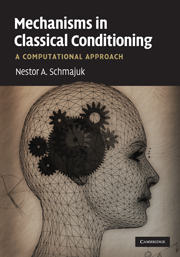Book contents
- Frontmatter
- Contents
- Preface
- Acknowledgments
- Abbreviations
- Part I Introduction
- Part II Attentional and associative mechanisms
- 2 An attentional–associative model of conditioning
- 3 Simple and compound conditioning
- 4 The neurobiology of fear conditioning
- 5 Latent inhibition
- 6 The neurobiology of latent inhibition
- 7 Creativity
- 8 Overshadowing and blocking
- 9 Extinction
- 10 The neurobiology of extinction
- Part III Configural mechanisms
- Part IV Attentional, associative, configural and timing mechanisms
- Part V Conclusion: mechanisms of classical conditioning
- References
- Author Index
- Subject Index
10 - The neurobiology of extinction
from Part II - Attentional and associative mechanisms
Published online by Cambridge University Press: 23 May 2010
- Frontmatter
- Contents
- Preface
- Acknowledgments
- Abbreviations
- Part I Introduction
- Part II Attentional and associative mechanisms
- 2 An attentional–associative model of conditioning
- 3 Simple and compound conditioning
- 4 The neurobiology of fear conditioning
- 5 Latent inhibition
- 6 The neurobiology of latent inhibition
- 7 Creativity
- 8 Overshadowing and blocking
- 9 Extinction
- 10 The neurobiology of extinction
- Part III Configural mechanisms
- Part IV Attentional, associative, configural and timing mechanisms
- Part V Conclusion: mechanisms of classical conditioning
- References
- Author Index
- Subject Index
Summary
Following the ideas proposed in Chapters 4 and 6, this chapter applies the “conceptual nervous system” provided by the SLG model in order to establish brain–behavior relationships during extinction. We applied the SLG model to the simulation of (a) Frohardt et al.'s (2000) data showing that neurotoxic hippocampal lesions eliminate reinstatement in rats, and (b) LaBar and Phelps's (2005) study showing that reinstatement is absent in patients with hypoxic damage to the hippocampus. As in Chapter 6, we assumed that neurotoxic hippocampal lesions, which injure the hippocampus proper (HPLs), impair the formation of (and changes in) CS–CS, CS–CX, CX–CX and CX–CS associations as defined in the SLG model. We will refer to these associations as between-CS associations. The same assumption was made for hypoxic hippocampal damage which results in human amnesia.
Effects of neurotoxic hippocampal lesions
A number of studies seem to indicate that selective excitotoxic hippocampal lesions (Talk, Gandhi & Matzel, 2002; but see Ward-Robinson et al., 2001), fimbrial lesions (Port & Patterson, 1984), and kainic lesions of hippocampal CA1 (Port, Beggs & Patterson, 1987) impair the acquisition of between-CS associations. In the framework of the SLG model, Buhusi et al. (1998, see Equations [6.1a] and [6.1b] in Chapter 6) described the effect of these lesions by assuming that between-CS associations, presumably stored in cortical areas, remain zero. They also assumed that associations of the CS with itself, which produce habituation to the CS, are modified when the CS is perceived.
- Type
- Chapter
- Information
- Mechanisms in Classical ConditioningA Computational Approach, pp. 234 - 242Publisher: Cambridge University PressPrint publication year: 2010



